Quarantine Read online
Page 4
Still, I have nothing better to do, so I search through the cargo records in the data I've collected so far, and come up with seven corpses.
The routine security X-rays taken of every passenger also provide the basis for computing the set of skeletal measurements used as an ID check. Corpses, though, aren't checked for ID; as with any other cargo, the X-ray images (a stereoscopic pair) are simply inspected by eye, then stored in the manifest. It takes me half an hour to track down a copy of the algorithm used by the airports to compute bone lengths; it's part of the X-ray machines' firmware, separate from the main passenger systems, so it isn't present in any of my stolen memory dumps. I wouldn't have wanted to cobble together a version of my own; the mathematics for converting data from stereo pairs to three-dimensional coordinates may be trivial, but automating the identification of the various bones is not.
I run the program on my seven corpses, checking for a match to Laura's data . . . and get seven consecutive negatives - perversely, just as I'm struck by a reason why the kidnappers might have chosen this path, after all. It's conceivable that Laura's brain damage prevented them from using a puppet mod; many off-the-shelf mods rely explicitly on the existence of certain neural structures which 'everyone' supposedly has in common, but which Laura might be lacking. No doubt any such problems could be circumvented, given time - but mapping Laura's non-standard brain, and reprogramming the nano-
32
machines accordingly, would be no trivial matter. Other solutions would have looked tempting.
The lack of a positive result rules out nothing; the X-rays in the cargo record could have been fudged, a few minutes after they were taken. Computerized information is as evanescent as the quantum vacuum, with virtual truths and falsehoods endlessly popping in and out of existence. Deceptions of any magnitude are possible, on a short enough time scale; laws only apply to data that sits still long enough to be caught out.
I skim through the X-ray analysis program, curious to see how it works, but the code for anatomical-feature recognition is pretty dull stuff, an interminable list of rules and exceptions, and the rest is a few lines of formulae. I had a faint, nagging doubt that differences in geometry between the cargo and passenger X-ray systems might have been giving me garbage results, but in fact all the relevant dimensions are stored along with the image pairs themselves, neatly tagged with standard descriptors, and the program takes nothing for granted.
Once the bone lengths have been computed, a match is declared if any discrepancies fall within an age-dependent tolerance limit, which makes allowance for the possibility of small changes since the visa was issued. This tolerance is highest, of course, for children and adolescents, and not much leeway is granted at Laura's age - perhaps I should increase it? Customs may prefer to err on the side of false negatives, but I'd rather make the opposite mistake.
I realize my stupidity with a jolt: I'm still thinking in terms of passengers. A fake corpse doesn't need to be ambulatory. No skeletal reconstruction, however crippling, can be ruled out - which leaves me without a single piece of data I can trust.
That's not quite true. Most bones can be altered - if a period of convalescence is acceptable - but it's next to impossible to mess with certain parts of the skull, without the tampering being both dangerous and obvious.
I modify the match criteria, stripping away all the other
33
comparisons. When I run this new version, a matching record appears at once:
cargo id: 184309547
Flight: QANTAS 295
Departure: Perth, 13:06, December 23rd, 2067
Arrival: New Hong Kong, 14:22, December 23rd, 2067
Contents: Human remains [Han, Hsiu-lien]
Sender: New Hong Kong Consulate General 16 St George's Terrace Perth 6000-0030016 Australia
Addressee: Wan Chei Funerals 132 Lee Tung Street Wan Chei 1135-0940132 New Hong Kong
A match on the basis of five skull measurements could be a coincidence. It could be deliberate misinformation. Why wouldn't the kidnappers have altered the X-rays, wiping out even this hint of the truth?
I check the time the snapshot was taken. Twelve fifty-three. The cargo would have been X-rayed just two or three minutes before; you don't risk changing data when a Customs officer might be staring right at it. Ten minutes later, though, and every trace of Laura Andrews would have been gone.
I shake my head, still suspicious. I don't often get this lucky.
Karen leans over my shoulder and says, "That's the definition of luck, you moron. Hurry up and pack.'
New Hong Kong was founded on January 1st, 2029. Eighteen months before - on the thirtieth anniversary of Hong Kong's absorption into the People's Republic of
34
China - demonstrations against the suspension of the Basic Law had ended in violent repression, a crackdown on dissent, and a massive increase in the rate of illegal emigration. While everyone else in the region offered the emigrants squalid refugee camps ringed with barbed wire, and the prospect of spending half their lives in a stateless limbo, the Tribal Confederation of Arnhem Land offered two thousand square kilometres on a mangrove-infested peninsula in northern Australia. No ninety-nine-year lease this time; sovereignty in perpetuity, in exchange for a piece of the action.
Arnhem Land, where the remnants of half a dozen Aboriginal tribes were trying to re-establish their near-obliterated culture, had been independent itself only since 2026, and there was talk in Australia of cutting off the aid that kept it afloat - partly in response to Chinese threats of trade sanctions, but also out of sheer childish resentment that the fledgling nation had dared to take its autonomy seriously. (The Australian government's own stunningly creative proposal had been to house sixty thousand refugees in a disused leper colony on the northwest coast, for however many decades it took to farm them out around the world at a politically acceptable rate.) The aid survived, but the project was widely ridiculed by the Australian media and their pet economists, who referred to it as 'subletting the nation', and predicted a social and financial disaster.
International investors thought otherwise; money flooded in. There was nothing humanitarian about this; it simply reflected the global economic situation at the time. The Koreans, especially, had been going crazy trying to find projects to soak up all their excess wealth. Creating the infrastructure from scratch must have been daunting, but the site was reasonably close to the booming industrial centres of south-east Asia, where there was engineering expertise and manufacturing capacity to spare. Making full use of new construction techniques, the core of the city was functional, and occupied, within seven years. Not a moment too soon: in
35
2036, the PRC invaded Taiwan, giving rise to a new wave of refugees.
In the decades that followed, cycles of political and economic reform came and went in Beijing, each one ending in an outflux of disillusioned members of the skilled middle class, with only one place to go. While China grew more impoverished and insular, New Hong Kong prospered. By 2056, its GDP had outstripped Australia's.
At Mach 2 plus, three thousand kilometres takes a little more than an hour. I'm far from any window, but I switch my entertainment screen to the scenic channel and watch the desert go by. I leave the headphones off, to avoid the fatuous audio commentary, but I can't work out how to make the distracting text and graphics overlays vanish. Eventually, I give up, and tell Boss to put me out of it until we arrive.
Monsoon rain pounds the runway as the plane touches down, but five minutes later I step out of the airport into dazzling sunshine and - after an hour of artificial, twenty-degree blandness - heat and humidity as palpable as a slap in the face.
To the north, I can glimpse the cranes of the harbour between the skyscrapers; to the east, a patch of blue, the Gulf of Carpentaria. I'm right beside an entrance to the underground, but since the rain has stopped, I decide to walk to my hotel. This is my first time in NHK, but I've loaded Deja Vu (Global Visage, $750) with an u
p-to-date street map and information package.
Sleek black towers from the early days alternate with the modern style: ornamental facades in imitation jade and gold, carved with ingenious fractal reliefs that catch the eye on a dozen different scales. Every building is topped with the giant logo of some major financial or information service. It always seems absurd to me that money or data should need a flag of convenience, but laws change slowly, and the laissez-faire regulations here have apparently tempted hundreds of transnationals to shift
36
their head offices to this jurisdiction - if only to await the day when they can incorporate incorporeally, as waves of tax-free data flowing between orbiting supercomputers.
At street level, the towers are all but hidden by the undergrowth of small traders. Daylight holograms in pai-hua and English crowd the air, each with a stream of flashing darts pointing out a narrow entrance or a tiny cubicle that might otherwise easily be missed. Processors, neural mods and entertainment ROMs are on sale within metres of junk jewellery, fast food, and nanoware cosmetics.
The crowd I move through looks prosperous: executives, traders, students, and plenty of the right kind of tourists. Twelve degrees south of the equator is about as far as most northern tourists will go; they want a winter tan, not the promise of a melanoma. Decades after the phasing out of the last ozone-depleting pollutants, the stratosphere remains contaminated - and the 'hole' which spreads out from Antarctica each spring is still severe enough to turn the latitude/cancer-risk equations upside down: sunlight is far more dangerous in the southern temperate zone than it is in the tropics. I'd better rapidly switch off my parochial UV-belt prejudice, and stop thinking of pale skin as marking out religious fanatics and genetic-purity freaks. Not many people born here (or in old Hong Kong) would have bothered with the melanin boost, but there's a visible component of black-skinned 'southerners' - Australian-born immigrants - of both Asian and European descent, so I may not be quite as conspicuously foreign as I feel.
The Renaissance Hotel was the least expensive I could find, but it's still disconcertingly luxurious, all red and gold carpet and giant murals of da Vinci sketches. NHK has no cheap accommodation; penniless backpackers simply don't get visas. I hate having my luggage carried, but I'd hate the fuss of refusing it even more. Several discreet signs advise against tipping; Deja Vu advises otherwise, and lets me know the going rate.
My room itself is small enough to make me feel slightly
37
less profligate, and the view consists of nothing but a portion of the Axon building - the fa$ade of which is tastefully adorned with the names of all their best-selling neural mods, spelt out in a dozen languages and repeated in all directions, like some abstract geometric tiling pattern. Letters cut into imitation black marble don't exactly catch the eye, but perhaps that's intentional; after all, Axon grew out of a company which peddled 'subliminal learning tools' - audio and video tapes bearing inaudible or invisible messages, supposedly perceived 'directly' by the subconscious. Like all the other self-improvement snake oil of the time, this did more than provide placebo effects for the gullible and megabucks for the rip-off merchants; it also helped create the market for a technology that did work, once such a thing was actually invented.
I unpack, shower, belatedly put all the clocks in my head forward one-and-a-half hours, then sit on the bed and try to decide exactly how I'm going to And Laura in a city of twelve million people.
The funeral notices say that Han Hsiu-lien was cremated on December 24th, and no doubt the body that went into the furnace looked just like her - although presumably the real Han Hsiu-lien never left Perth. All this corpse shuffling is fascinating, but it doesn't get me very far. If I talk to anyone at the funeral company, I risk tipping off the kidnappers. Ditto for the airline's cargo handlers. All the people most likely to have seen something useful are also the most likely to have been involved in the swap themselves.
So where does that leave me? I still know nothing about the kidnappers, nothing about their motives, nothing about their plans. Apart from having narrowed the search geographically, I'm back to square one. All I have to go on is Laura herself, brain-damaged and immobile. I might as well be hunting for an inanimate object.
But she's not an inanimate object, she's a human being convalescing from skeletal reconstruction. Convalescing - what does that entail? Highly skilled nursing and
38
physiotherapy - assuming that her kidnappers care whether or not she ends up permanently crippled. Medication, certainly - if she's worth keeping alive at all, they can't be disregarding her health entirely. But what medication, what particular drugs? I have no idea. So I'd better find out.
Doctor Pangloss is my favourite knowledge miner. Unlike Bella, who steals data which is supposed to be secure, Pangloss legally digs up facts which are -laughably - supposed to be easily accessible to anyone, for a few dollars, at the touch of a few keys. His mask, with powdered wig and beauty spot, always makes me think of Moliere rather than Voltaire, and his accent is pure RSC, but there's no quibbling about his mining skills; he answers my question in thirty seconds flat. I could have consulted the same expert systems, databases and libraries myself, but it would have taken me hours.
A patient in Laura's condition would have several pharmacological requirements, each of which could be met by a variety of substances, each in turn marketed under several different trade names, and each available from a choice of local suppliers. Pangloss arranges all of this for me in a neat tree diagram in midair, then sends a copy down the data channel.
I call Bella, pass her the list of pharmaceutical suppliers, and ask for their delivery records for the last three months.
'Five hours,' she says. 'Your password is "nocturne".'
Five hours. I spend ten minutes staring out the window, trying to think of something useful to do in the meantime. Nothing comes to mind, so I decide to eat.
The hotel's ground-floor restaurant looks stuffy and expensive, so I wander out in search of fast food. NHK has its own distinctive cuisine, mainly Cantonese in ancestry, but full of local quirks -like crocodile meat from Arnhem Land; delicious, according to Deja Vu, so long as you're not put off by the possibility of secondary cannibalism. I settle for fried rice.
39
I still have hours to kill, so I walk on, aimlessly. I tell myself I'm going to think about the case, but the truth is I'm sick of chasing the same details in the same endless circles, and I let my mind go blank. The rush-hour crowd presses around me, full of tense and anxious faces - which usually makes me tense and anxious myself, but right now I seem to be immune, as if I haven't yet tuned in to this city and can't yet be touched by its moods.
I step into a false dusk, the shadow of the PanPacific Bank tower, a hundred-storey cylinder sheathed in corroded gold. Deja Vu gives me the tourist spiel: Hsu Chao-chung's most famous and controversial work, completed in 2063. The metallic-looking cladding is in fact a polymer; the fractal dimension of the surface is an unsurpassed 2.7 .. . The commentary is more abstract than an auditory hallucination - more like vividly imagined or remembered speech; a documentary soundtrack effortlessly recalled. The catch is, the mod also pumps out a deliberate subtext: a sense of growing familiarity, a sense that you're gaining the most profound and intimate knowledge, a sense that with each piece of predigested trivia you swallow, you're fast approaching an understanding of the place to rival that of any lifelong citizen. This is precisely the delusion that every tourist wants, but personally I'd rather stay slightly less complacent.
The sky grows dark quickly once the sun truly sets. Karen walks beside me, silent at first, but I only need the sight of her in the corner of my eye, and the faint scent of her skin, to take the edge off my loneliness.
We find ourselves in an open-air market, an endless expanse of stalls and tables piled with souvenirs, trinkets and high-tech consumer junk. Clashing multicoloured light, spilling from the holograms jostling above the stalls like d
emon spruikers, renders everything in the strangest hues.
'Do we want an intelligent salad-maker? "Faster and more dextrous than any mere human with a chef mod".' She shakes her head.
40
'What about this? A key eliminator. "Memorizes and mimics the geometric, electrical, magnetic and optical properties of up to one thousand different keys, active or passive".'
Ί don't think so.'
'Come on. My hotel bill's under the quota; I have to buy something, or they'll never let me in again. The Chamber of Commerce computer will veto my visa application.'
'How about a horoscope?' She nods towards a nearby astrologer's booth.
My stomach tightens. 'Since when did you believe in that shit?' A young boy turns to stare at me addressing empty space, but his friend grabs his elbow and drags him on, whispering an explanation.
Ί don't. Just humour me.'
I glance at the booth, and force out a laugh. 'Astrology . . . without any fucking stars. That says it all.'
Her face is unreadable. 'Humour me.'
My guts are squirming, but I say, almost calmly, 'Okay. If you want a horoscope, I'll buy you a horoscope. April 10th.'
She shakes her head. 'Not mine, you idiot. Laura's.'
I stare at her, then shrug. There's no point arguing. I still have all the Hilgemann patient records in my head. Laura was born on August 3rd, 2035.
The astrologer is a shaven-headed girl, four or five years old, dressed in fake silk and dripping glass jewellery. I give her Laura's details. She sits cross-legged on a cushion and writes with a bamboo pen on ersatz parchment. Her calligraphy is rapid, but undeniably elegant; the mod for it must have cost a fortune - manual skills never come cheap. When she's covered the sheet, she turns it over and writes an English version on the back. I hand her my credit card, and put my thumb to the scanner. When I take the parchment, she clasps her hands together and bows.
Karen has vanished. I read the prediction, which boils down to success in business and happiness in love (after

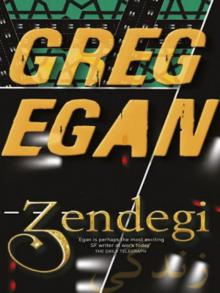 Zendegi
Zendegi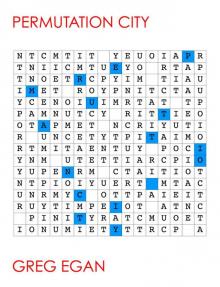 Permutation City
Permutation City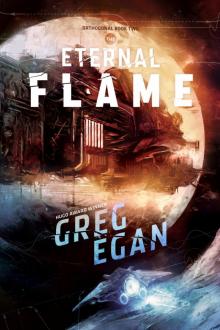 The Eternal Flame
The Eternal Flame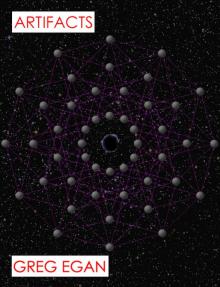 Artifacts
Artifacts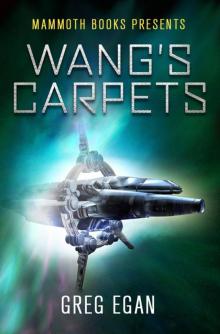 Wang's Carpets
Wang's Carpets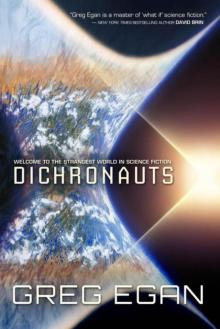 Dichronauts
Dichronauts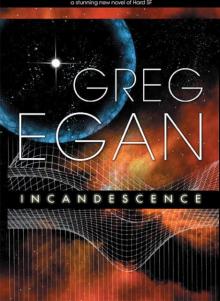 Incandescence
Incandescence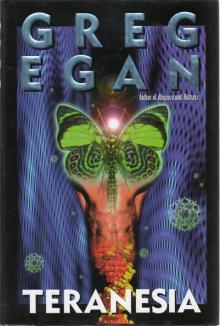 Teranesia
Teranesia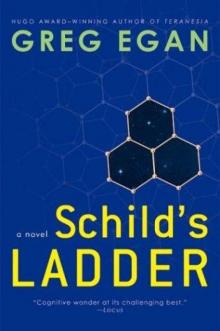 Schild's Ladder
Schild's Ladder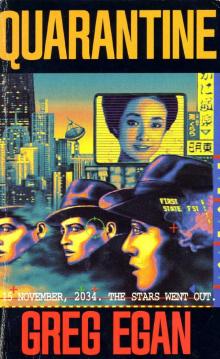 Quarantine
Quarantine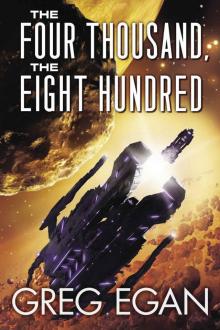 The Four Thousand, the Eight Hundred
The Four Thousand, the Eight Hundred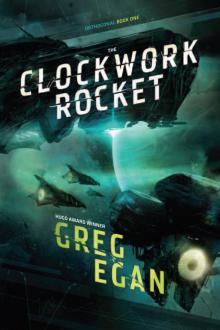 The Clockwork Rocket
The Clockwork Rocket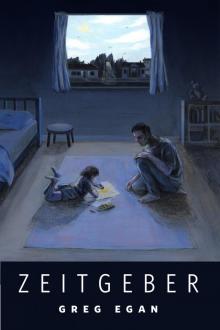 Zeitgeber
Zeitgeber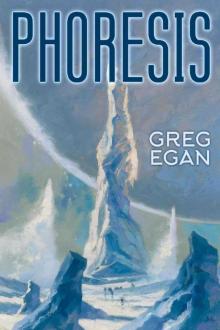 Phoresis
Phoresis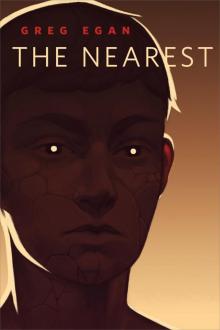 The Nearest
The Nearest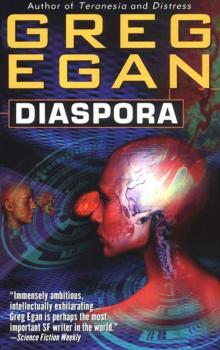 Diaspora
Diaspora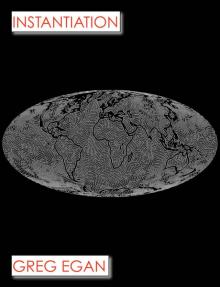 Instantiation
Instantiation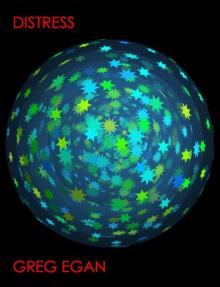 Distress
Distress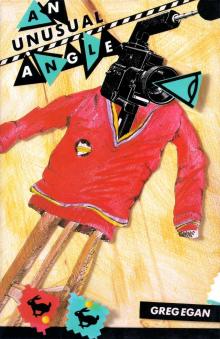 An Unusual Angle
An Unusual Angle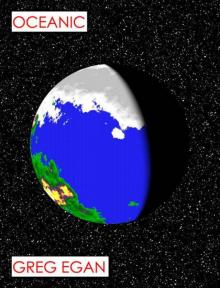 Oceanic
Oceanic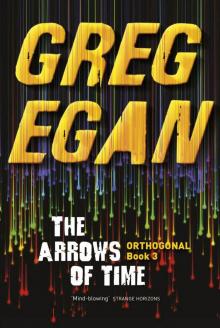 The Arrows of Time
The Arrows of Time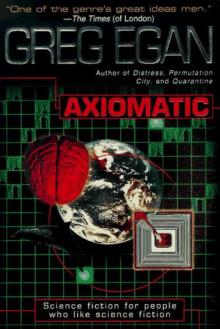 Axiomatic
Axiomatic![Anthology 2. Luminous [1998, 2010] Read online](http://i1.bookreadfree.com/i/03/18/anthology_2_luminous_1998_2010_preview.jpg) Anthology 2. Luminous [1998, 2010]
Anthology 2. Luminous [1998, 2010]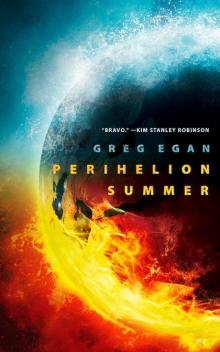 Perihelion Summer
Perihelion Summer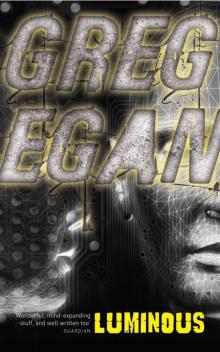 Luminous
Luminous